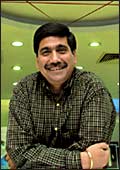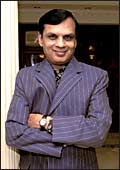 |
| LG's Kim: Life definitely good in India |
The
Korean consumer electronics giant that has been creating ripples
across the world in the past few years is Samsung. According to
Interbrand, a global brand consultancy, Samsung's brand value
shot up an astounding 186 per cent in the past five years to $14.9
billion (Rs 65,560 crore) in 2004. Samsung ranked 20th, well ahead
of the venerable Japanese giant Sony (ranked at 28th) in Interbrand's
top 100 global brand ranking for 2005. Samsung's compatriot and
the main rival globally, LG, was at a distant 97th position, its
brand being valued at a measly $2.6 billion (Rs 11,440 crore).
Not only that, Samsung's global sales at $56 billion (Rs 2,46,400
crore) were also 47 per cent higher than LG's $38 billion (Rs
1,67,200 crore).
That's the global story. Zoom into the Indian
market and it's a totally different tale. Here, it's LG that rules
the roost. There is no Indian version of Interbrand's brand survey
to validate the point, but if consumer preference and sales across
product categories are any indication, LG is a clear market leader,
accounting for around 26 per cent of the Rs 25,000-crore Indian
consumer electronics industry. Besides, it leads each and every
major category and sub-category of around half-a-dozen businesses,
including refrigerators, televisions, washing machines and microwave
ovens, that it operates in (see LG All The Way). "The aggression
that LG India has unleashed in the past four to five years (it
spends 5 per cent of its total turnover on advertising and promotions)
on the brand communication front, has given it the ubiquity it
lacks globally. LG is a much more relatable name in India now
than any of its competitors," says Harish Bijoor, CEO, Harish
Bijoor Consults, a Banglore-based marketing consultancy.
That's a feat LG has accomplished in a span
of only eight years. When it first entered the Indian market in
1993, LG used to be known as Lucky Goldstar, a descendant of a
47-year-old Korean enterprise that began with the manufacture
of cosmetics, with a flagship product called Lucky Cream. It formed
a joint venture with a local electronics firm Bestavision as foreign
investment norms then didn't allow independent foreign ventures.
The company (the name was changed to LG in 1995) became a 100
per cent subsidiary of its Korean parent immediately after the
restriction was lifted in 1997. There has been no looking back
since then.
"India has been a success story for
us. In the past eight years, we have grown not only in terms of
turnover, but also in terms of our brand awareness, recall and
acceptance," says Kwang Ro Kim, MD, LG Electronics India.
Adds VP, sales, Girish Rao: "On an average, we have grown
30 per cent year-on-year in the past eight years against the industry
average of 10 per cent."
| SLOWDOWN IN DURABLES SALE: BLIP AND WHY |
| Does the boom
in the equity market have any correlation with the sales in
the consumer electronics sector? "My observation has
been that whenever the stock markets are bullish, consumer
durables sales go down," says T.K. Banerjee, President
and CEO, Haier India.
The first half of 2005 has been good for most of the sectors
(including FMCG, which had remained stagnant in 2004), with
the only exception of consumer electronics.
Equity analysts, however, don't agree with the theory.
"It's a far-fetched argument," says Jigar Shah,
director, KP Choksey. Some analysts, however, maintain that
it's FMCG and consumer durables sectors that are inversely
linked. "Last year, FMCG sales took a hit on account
of consumers' increased spends on consumer durables,"
says Animesh Singh, a research analyst. This argument is
scoffed at by others. "It seems unlikely that spends
on soaps and toothpaste are curtailed to buy a colour TV
or a refrigerator," says Ireena Vittal, Principal,
McKinsey India.
So what explains the slowdown in the consumer electronics
sales in the first half of 2005? The January-June period
was so bad that even the market leader LG had to slash its
turnover target from Rs 8,500 crore to Rs 8,000 crore. "It
was the confusion regarding VAT (value-added tax) that took
its toll on sales," says Girish Rao, VP, sales, LG.
Agrees Ravinder Zutshi, Deputy MD, Samsung: "Dealers
were wary of taking in new stocks because of the vagueness
surrounding VAT."
|
On an overall basis, LG currently enjoys a
29.4 per cent share (by volume) in refrigerators, 26.5 per cent
in colour TVs, 35.8 per cent in washing machines and 38 per cent
in microwave ovens. After its state-of-the-art manufacturing facility
at Greater Noida in up, which was built in 1998 with an investment
of Rs 500 crore, it set up another factory in Ranjangaon near
Pune last year where it will invest Rs 900 crore over the next
three years. The new factory has been manufacturing mobile phones
along with all other consumer electronics products since October
2004. The company has already eked out a 6 per cent share in the
GSM handsets business.
LG's turnover has grown at a scorching 5,100
per cent from Rs 125 crore in 1997 to Rs 6,500 crore in 2004-something
that even its competitors marvel at. "To LG goes the credit
of bringing life back to a lacklustre consumer electronics sector
in India. Besides growing itself, LG has grown the overall market,"
says T.K. Banerjee, CEO, Haier, the Chinese consumer electronics
company.
Mass Market Leader
But, not all competitors acknowledge Kim
and his team's business acumen. The Korean giant is most often
accused by its rivals for having played the game the wrong way.
"LG introduced unsustainable price points in the market.
It owes it success to its mass-market strategy," says the
chief executive of a top company. His argument finds an echo in
Samsung India's Deputy MD Ravinder Zutshi's assertion. "LG
is a leader only in mass categories, whereas all the premium segments
are ruled by Samsung."
Some even lay the blame for the debacle of
several established players on LG's aggressive pricing strategy.
Indeed, companies like Voltas and BPL faced difficulties in the
last couple of years; the latter slipped into heavy losses (Rs
268.3 crore for the 18-month ended March 31, 2005) after its TV-manufacturing
business went bust even as LG's TV business was gathering pace.
But LG refutes such allegations.
"Even today, there are more than half-a-dozen
brands that are priced 15-25 per cent lower than our products,"
says Girish Bapat, VP, Marketing, LG, pointing to home-grown player
Videocon's Sansui and Akai brands. Experts maintain that prices
in Indian market were traditionally higher than other global markets
and that deterred the growth of the industry to a large extent.
"Consumer electronics products couldn't move beyond metros
and class A towns because the masses simply couldn't afford them,"
says Arvind Singhal, chairman, KSA Technopak, a management consulting
firm.
 |
| Samsung's Zutshi: Is not ready to give
ground; says LG is leader only in mass categories |
The scenario changed after LG, with its low-priced
products, forced its way into rural markets. Some experts maintain
that the premium product categories, which are still quite steeply
priced, will also have to go the same way. "To ensure a consistent
growth and a better penetration, players will have to scale down
the prices of niche products and introduce new variants in mass
categories at a much faster pace," says Ireena Vittal, Principal,
McKinsey India.
Meanwhile, LG's go-rural strategy has paid
off in many ways. "It helped the company in achieving economies
of scale. Hence, it could afford to reduce its prices, and push
the sales further," says Singhal.
According to Rao, LG, on an average, generates
more than 50 per cent of its total turnover from rural markets,
whereas the industry average still is 70:30 in favour of urban
markets. In fact, the Korean chaebol has one of the biggest rural
distribution networks in the country. It has 72 remote area offices
reporting to 86 central area offices, who finally report to 47
branch offices. Each of these offices has independent customer
servicing, marketing and sales teams, which offer consumers tailor-made
solutions.
"Unlike other MNCs, who come to India
because it is another happening market, LG has shown determination
to be a long-term player," says Bijoor. "Its commitment
is reflected in heavy investments made in state-of-the-art manufacturing
facilities, distribution network, communications and the keenness
to strike a direct rapport with consumers," adds Singhal.
Big Ticket Spender
LG hasn't skimped on advertising and marketing
either and has invested heavily in cricket, despite the sport
being one of the most expensive properties for marketers. LG spent
around Rs 250 crore on buying the sponsorship rights of two World
Cups and three Challenger Trophies in 2002 from the International
Cricket Council. It also has an array of stars like Sourav Ganguly,
Srikant, Sunil Gavaskar and Yuvraj Singh as its brand endorsers.
"Cricket helps in cashing in on the emotional bond the sport
has with Indian consumers," says Bapat.
 |
| Videocon's Dhoot: Attributes LG's success
to lack of competition; is now ready to give it a run for
its money |
It certainly has been good going for the Korean
giant so far, but now the competition is stirring alive. "LG
thrived all this while because there was no serious competition
in the market; some of the top brands were either lying dormant
or were consolidating their position," says Venugopal Dhoot,
Chairman and MD, Videocon. He asserts that his company, with renewed
vigour gained from the recent deals with Thomson and Electrolux
(see Business Today, dated July 31, 2005, The Great Gambler) and
surplus cash from the group's oil business of Rs 700 crore, will
soon give LG a run for its money.
Meanwhile, others like Mirc Electronics (which
owns the Onida brand) and Whirlpool have also got their act together,
while Samsung and Godrej are firming up their expansion plans.
If BPL's proposed Rs 1,400-crore restructuring plan sees the light
of the day, it will be another player to contend with. Is LG ready
to take on the new challenges?
"More than ready," says the trio
of Kim, Rao and Bapat. Unlike all the other players (Samsung is
an exception), it has an extended presence in all product categories,
which gives it a broader scale. It is also exploring new areas
of growth. While Samsung is gradually entering the mass segment,
LG is pursuing the premium route. It has set up 75 exclusive LG
galleries for high-end products like Dios refrigerators (priced
Rs 50,000 and above), Whisen range of wall-mounted acs (Rs 50,000
and above), X-Canvas plasma screens (Rs 1 lakh and above) and
also aims to boost its it product portfolio. A DVD writer plant
in Ranjangaon, with an investment of around Rs 300 crore, is already
on its way. LG expects these categories to contribute 10 per cent
to its total revenue soon.
It may have had to cut its 2005 projections
(see Slowdown In Durable...), but Kim and his team say that they
are well on their way to meet their 2010 target of becoming a
$10 billion (Rs 44,000 crore) company in India. Rivals chortle
that such an ambition is a pipe dream and cite projections that
the entire Indian consumer electronics industry (now valued at
Rs 25,000 crore) will probably be just Rs 40,000-45,000 crore
by then. Would LG then become bigger than the industry itself?
Kim and his team may well draw attention to its past-when LG India
grew 52 times in eight years. Or they could point to the company's
pithy slogan, "Life is Good", and simply say that it
is getting better!
|






